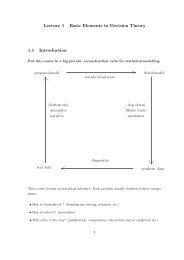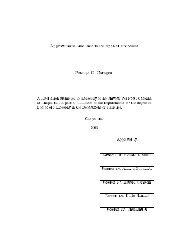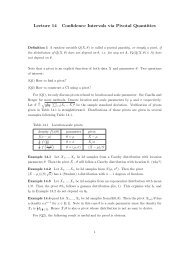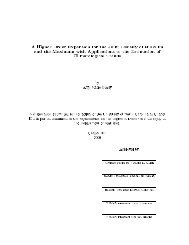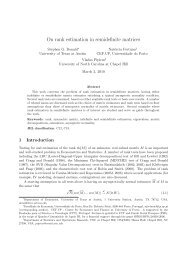Monte Carlo Methods in Statistical Mechanics: Foundations and ...
Monte Carlo Methods in Statistical Mechanics: Foundations and ...
Monte Carlo Methods in Statistical Mechanics: Foundations and ...
You also want an ePaper? Increase the reach of your titles
YUMPU automatically turns print PDFs into web optimized ePapers that Google loves.
Note rst that the only slow modes <strong>in</strong> the damped Jacobi iteration are the longwavelengthmodes<br />
(provided that ! is not near 1): as long as, say, max(p1p2) 2 ,we<br />
3<br />
1<br />
have 0 p 4 (for ! = 2 ), <strong>in</strong>dependent ofL. Itfollows that the short-wavelength<br />
components oftheerror e (n) ' (n) ; ' can be e ectively killed by a few (say, ve<br />
or ten) damped Jacobi iterations. The rema<strong>in</strong><strong>in</strong>g error has primarily long-wavelength<br />
components, <strong>and</strong> so is slowly vary<strong>in</strong>g <strong>in</strong>x-space. But a slowly vary<strong>in</strong>g function can<br />
be well represented on a coarser grid: if, for example, we were told e (n)<br />
x only at even<br />
values of x, we could nevertheless reconstruct with highaccuracythe function e (n)<br />
x at all<br />
x by, say, l<strong>in</strong>ear <strong>in</strong>terpolation. This suggests an improved algorithm for solv<strong>in</strong>g (5.1):<br />
perform a few damped Jacobi iterations on the orig<strong>in</strong>al grid, until the (unknown) error<br />
is smooth <strong>in</strong>x-space then set up an auxiliary coarse-grid problem whose solution will<br />
be approximately this error (this problem will turn out tobeaPoisson equation on the<br />
coarser grid) perform a few damped Jacobi iterations on the coarser grid <strong>and</strong> then<br />
transfer (<strong>in</strong>terpolate) the resultbacktothe orig<strong>in</strong>al ( ne) grid <strong>and</strong> add it <strong>in</strong> to the<br />
current approximate solution.<br />
There are two advantages to perform<strong>in</strong>g the damped Jacobi iterations on the coarse<br />
grid. Firstly, the iterations take lesswork, because there are fewer lattice po<strong>in</strong>ts onthe<br />
coarse grid (2 ;d times as many for a factor-of-2 coarsen<strong>in</strong>g <strong>in</strong>d dimensions). Secondly,<br />
with respect to the coarse grid the long-wavelength modes no longer have such long<br />
wavelength: their wavelength has been halved (i.e. their wavenumber has been doubled).<br />
This suggests that those modes with, say, max(p1p2) 4 can be e ectively killed<br />
by a few damped Jacobi iterations on the coarse grid. And then we can transfer the<br />
rema<strong>in</strong><strong>in</strong>g (smooth) error to ayet coarser grid, <strong>and</strong> so on recursively. Theseare the<br />
essential ideas of the multi-grid method.<br />
Let us now give aprecisede nition of the multi-grid algorithm. For simplicity<br />
we shall restrict attention to problems de ned <strong>in</strong> variational form16 : thus, the goal is<br />
to m<strong>in</strong>imize a real-valued function (\Hamiltonian") H('), where ' runs over some<br />
N-dimensional real vector space U. Weshall treat quadratic <strong>and</strong> non-quadratic Hamiltonians<br />
on an equal foot<strong>in</strong>g. In order to specify the algorithm we must specify the<br />
follow<strong>in</strong>g <strong>in</strong>gredients:<br />
1) A sequence of coarse-grid spaces UM U UM;1 UM;2 ::: U0. Here dim Ul<br />
Nl <strong>and</strong> N = NM >NM;1 >NM;2 > >N0.<br />
2) Prolongation (or \<strong>in</strong>terpolation") operators pll;1: Ul;1 ! Ul for 1 l M.<br />
3) Basic (or \smooth<strong>in</strong>g") iterations Sl: Ul Hl ! Ul for 0 l M. HereHl is<br />
a space of \possible Hamiltonians" de ned on Ul we discuss this <strong>in</strong> more detail<br />
below. Therole of Sl is to takeanapproximate m<strong>in</strong>imizer ' 0 l of the Hamiltonian Hl<br />
<strong>and</strong>computeanew (hopefully better) approximate m<strong>in</strong>imizer ' 00<br />
l = Sl(' 0 l Hl). [For<br />
16 In fact, the multi-grid method can be applied to the solution of l<strong>in</strong>ear or nonl<strong>in</strong>ear systems of<br />
equations, whether or not these equations come from a variational pr<strong>in</strong>ciple. See, for example, [32] <strong>and</strong><br />
[20, Section 2].<br />
27



